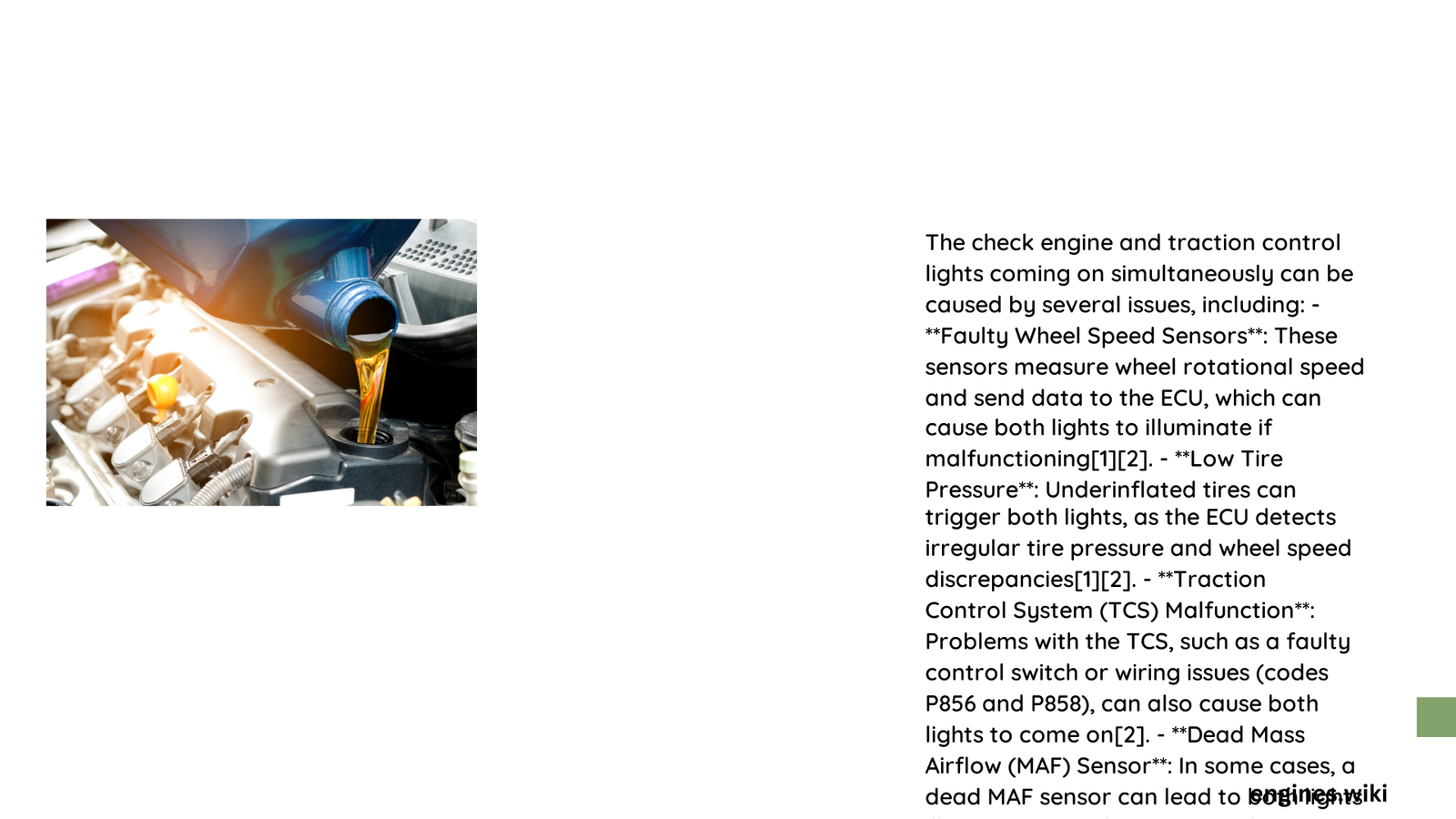When your vehicle’s dashboard suddenly illuminates both the check engine and traction control lights, it signals a complex automotive system malfunction that demands immediate attention. These warning indicators represent interconnected electronic systems communicating potential mechanical issues, ranging from sensor failures to critical performance disruptions that could compromise your vehicle’s safety and operational integrity.\n\n## What Triggers Check Engine and Traction Light Simultaneously?\n\nMultiple factors can cause these warning lights to activate concurrently, including:\n\n### Sensor-Related Complications\n- Wheel Speed Sensor Failures\n- Throttle Position Sensor Malfunctions\n- Oxygen Sensor Circuit Disruptions\n\n### Diagnostic Trouble Codes (DTCs) Overview\n\n| Code | System | Potential Issue |\n|——|——–|—————-|\n| C1506 | Traction Control | Right Rear Valve Malfunction |\n| P0856 | Electrical | Traction Control Switch Circuit Problem |\n| P0120 | Engine Management | Throttle Position Sensor Failure |\n\n## How Do Wheel Speed Sensors Impact Warning Lights?\n\nWheel speed sensors play a critical role in both traction control and engine management systems. When these sensors malfunction, they can trigger multiple warning indicators simultaneously. Key considerations include:\n\n1. Sensor Physical Condition\n – Check for physical damage\n – Inspect wiring harness\n – Verify sensor alignment\n\n2. Environmental Factors\n – Road debris interference\n – Moisture accumulation\n – Extreme temperature variations\n\n## What Should You Do When Lights Activate?\n\n### Immediate Action Steps\n- Do Not Ignore Warning Lights\n- Use OBD-II Scanner\n- Read Specific Diagnostic Trouble Codes\n- Consult Professional Mechanic\n\n## Can Tire Pressure Affect Warning Lights?\n\nTire pressure significantly influences both traction control and engine management systems. Underinflated or unevenly pressurized tires can trigger warning lights by disrupting sensor readings and vehicle stability calculations.\n\n### Tire Pressure Diagnostic Checklist\n- Verify recommended tire pressure\n- Check all four tires\n- Inspect tire wear patterns\n- Use calibrated tire pressure gauge\n\n## Why Professional Diagnosis Matters\n\nWhile some issues might seem minor, simultaneous check engine and traction light activation could indicate complex systemic problems requiring specialized diagnostic equipment and expertise. Professional mechanics can:\n\n- Perform comprehensive system scans\n- Identify root cause of warning lights\n- Prevent potential long-term damage\n- Ensure vehicle safety\n\n## Technical Insights: System Interconnectivity\n\nModern vehicles feature intricate electronic systems where traction control, engine management, and safety mechanisms are deeply interconnected. A malfunction in one system can cascade into multiple warning indicators, emphasizing the importance of holistic diagnostic approaches.\n\n### Key Diagnostic Considerations\n- Electronic Control Unit (ECU) communication\n- Sensor network integrity\n- Cross-system performance monitoring\n\n## Preventive Maintenance Strategies\n\n1. Regular vehicle inspections\n2. Timely sensor replacements\n3. Consistent tire maintenance\n4. Professional diagnostic checks\n\n## Conclusion\n\nUnderstanding the complexities behind check engine and traction light activation requires technical knowledge and systematic approach. While some issues might be straightforward, professional assessment remains crucial for comprehensive vehicle health.\n\n### Reference:\n- National Highway Traffic Safety Administration\n- Society of Automotive Engineers\n- ASE Certification Resources

